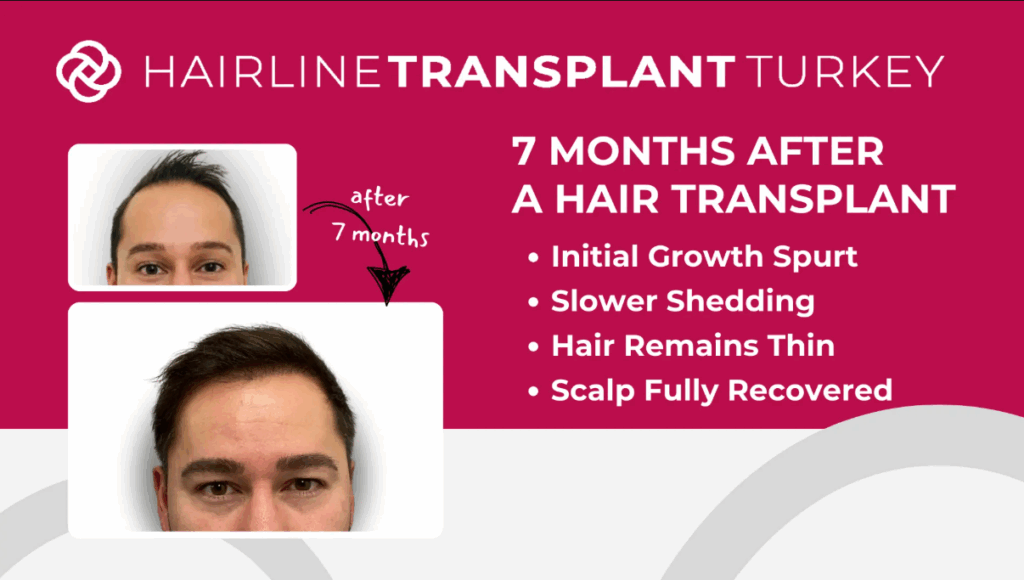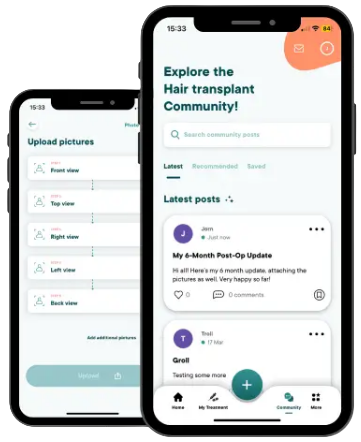Seven months following your hair transplant is a crucial time within your hair restoration experience. As weeks pass by, you’ll notice remarkable things occurring new growth of your hair, thicker hair, and increased confidence. But with anticipation often comes concern: What will you notice changing? What are hints at enhancing your results? Here, we will examine the remarkable transformation of your hair, provide essential tips on caring for your new hair, and help you navigate potential problems. If you are celebrating your progress or seeking answers for your queries, then this useful resource guide will aid you in your enjoyment of your journey towards thicker hair. Prepare yourself by learning how you can benefit from your transformation, your best days with your hair are on the horizon!
In this guide
Understanding Hair Transplant Procedures
Hair transplant procedures have revolutionized the way we combat hair loss. These surgeries involve extracting hair follicles from one part of the body, typically the back or sides of the scalp, and transplanting them to the balding or thinning areas. Two primary techniques are widely used: Follicular Unit Transplantation (FUT) and Follicular Unit Extraction (FUE). FUT involves removing a strip of scalp from the donor area and dissecting it into individual grafts, while FUE entails harvesting hair follicles directly from the donor site one by one. Both methods have their pros and cons, but advancements in technology have made both options viable and effective for most patients.
Understanding the intricacies of these procedures is crucial for prospective patients. FUT is often recommended for those needing a larger number of grafts and who don’t mind a linear scar, whereas FUE is favored for its minimal scarring and quicker recovery time. The choice between FUT and FUE depends on various factors, including the extent of hair loss, the quality and quantity of donor hair, and personal preferences. Consulting with a skilled and experienced surgeon can help determine the best approach tailored to individual needs.
The success of hair transplant surgery is heavily dependent on the expertise of the medical team and the patient’s adherence to post-operative care instructions. Proper planning, precise execution, and diligent aftercare are essential components that contribute to the overall success of the procedure. As you embark on this transformative journey, understanding the nuances of hair transplant procedures will empower you to make informed decisions and set realistic expectations for the outcome.
What Happens at 7 Months After Hair Transplant?
Reaching the seven-month milestone post-hair transplant is nothing short of exhilarating. By this point, most patients begin to observe significant changes in their hair growth. The initial shedding phase, which typically occurs within the first few weeks, is well behind you. Now, you can expect to see new hair sprouting and filling in the previously barren areas. This period is marked by noticeable improvements in hair density and volume, giving you a glimpse of the final results yet to come.
At seven months, the transplanted hair continues to grow and mature. The new hair may still be fine and slightly wavy, but it will gradually thicken and blend seamlessly with your natural hair over time. It’s important to remember that hair growth patterns vary from person to person, and while some may experience rapid progress, others might see more gradual changes. Patience is key during this period, as the full outcome of the transplant can take up to 12-18 months to manifest completely.
In addition to visible hair growth, you may also notice changes in the texture and strength of your new hair. Initially, the transplanted hair may feel coarser or different from your natural hair, but this typically normalizes as the follicles settle and adapt to their new location. Regular follow-ups with your surgeon are crucial to monitor progress and address any concerns. These check-ins provide an opportunity to fine-tune your hair care regimen and ensure you’re on track for optimal results.
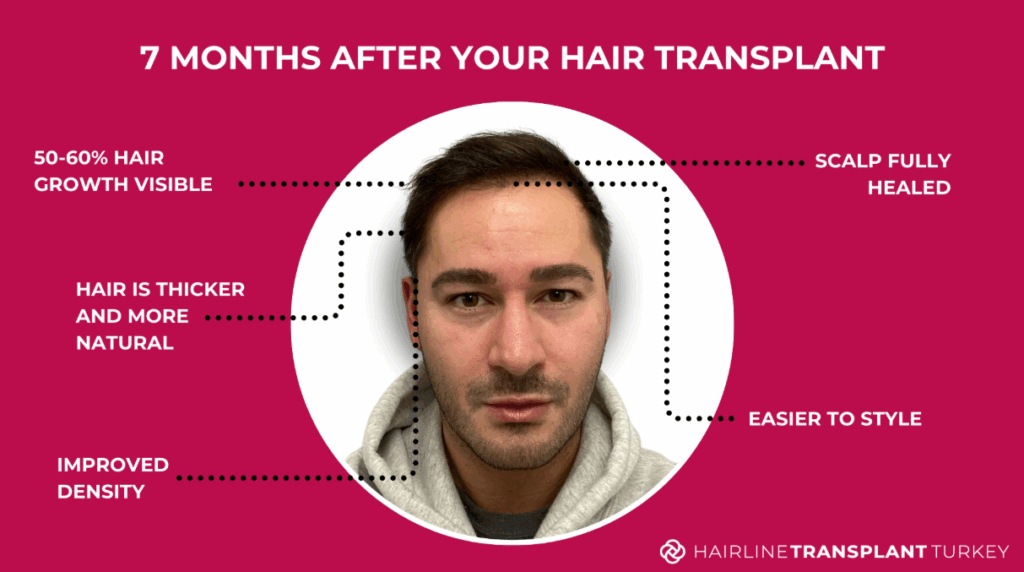
The timeline for hair regrowth can vary significantly depending on several factors:
- The quality and type of hair follicles transplanted
- Your individual healing process
- The size of the transplant area
- Genetic factors influencing hair growth
While some patients experience faster and more visible results by 7 months after hair transplant, others may still feel that their hair appears thin and lacks fullness.
Common Transformations After 7 Months
The seven-month mark is often a turning point in the hair transplant journey, bringing about several exciting transformations. One of the most noticeable changes is the increased density of your hair. The once sparse areas of your scalp begin to fill in, creating a fuller and more natural appearance. This newfound volume not only enhances your overall look but also boosts your confidence, allowing you to experiment with different hairstyles and grooming options.
Another common transformation is the improvement in hair texture. Initially, the transplanted hair may appear wiry or unruly, but over time, it begins to soften and blend seamlessly with your existing hair. This transition is a sign that the follicles are thriving in their new environment and adapting to the natural growth cycle. Consistent care and adherence to recommended hair care practices can further enhance this process, ensuring your hair looks and feels as natural as possible.
Additionally, many patients experience a positive shift in their self-esteem and emotional well-being. The visible progress in hair growth often translates to a renewed sense of self and an uplift in mood. This psychological transformation is just as significant as the physical changes, as it can have a profound impact on your overall quality of life. Embracing these positive changes and celebrating your progress is an essential part of the hair transplant journey.
Factors Influencing Hair Growth Post-Transplant
Several factors can influence the rate and quality of hair growth following a hair transplant. One of the primary determinants is the patient’s age. Younger individuals tend to experience faster and more robust hair growth due to their more active hair follicles and healthier scalp conditions. However, this doesn’t mean older patients won’t see significant results; it may just take a little longer for their hair to reach its full potential.
Another crucial factor is the density and quality of the donor hair. The success of a hair transplant largely depends on the availability of healthy hair follicles from the donor area. Patients with a dense donor area typically achieve better coverage and natural-looking results. The characteristics of the donor hair, such as texture, color, and curl, also play a role in how well the transplanted hair blends with the existing hair.
Post-operative care and adherence to the surgeon’s instructions are vital components that can significantly impact hair growth. Proper care includes avoiding strenuous activities, protecting the scalp from direct sunlight, and following a prescribed hair care routine. Additionally, underlying health conditions, such as hormonal imbalances or nutritional deficiencies, can affect hair growth. Addressing these issues with the help of a healthcare professional can optimize your results and ensure the longevity of your new hair.
Essential Care Tips for Optimal Results
Achieving optimal results from your hair transplant involves more than just undergoing the procedure. Consistent and meticulous post-operative care is crucial for ensuring the longevity and health of your new hair. One of the most important care tips is to follow your surgeon’s instructions meticulously. This includes taking prescribed medications, avoiding certain activities, and adhering to recommended hair care practices.
Gentle handling of your hair and scalp is essential during the recovery period. Avoid using harsh shampoos or styling products that can irritate the scalp or damage the delicate hair follicles. Opt for mild, sulfate-free shampoos and conditioners that nourish the scalp and promote healthy hair growth. Additionally, refrain from vigorous towel drying or using high-heat styling tools, as these can weaken the hair and impede growth.
Incorporating a balanced diet rich in vitamins and minerals can also support hair health. Nutrients such as biotin, zinc, and vitamin E are known to promote hair growth and strengthen hair follicles. Staying hydrated and maintaining a healthy lifestyle, including regular exercise and adequate sleep, can further enhance the results of your hair transplant. By adopting these care tips, you can ensure that your new hair thrives and continues to grow beautifully.
Dealing with Hair Shedding: What’s Normal?
Hair shedding is a natural part of the hair growth cycle, and it’s crucial to understand what constitutes normal shedding post-hair transplant. During the initial weeks following the procedure, patients often experience a phase known as “shock loss,” where transplanted hair temporarily falls out. This can be alarming, but it is a normal response as the hair follicles enter a resting phase before beginning new growth.
Around the seven-month mark, it’s not uncommon to notice some degree of shedding as the hair continues to cycle through its growth phases. This shedding is typically not as extensive as the initial shock loss and is usually temporary. It’s essential to differentiate between normal shedding and excessive hair loss, which may indicate an underlying issue. Regular follow-ups with your surgeon can help monitor your progress and address any concerns regarding shedding.
To manage hair shedding effectively, ensure that you are following your post-operative care instructions diligently. Avoid stress and maintain a healthy lifestyle, as stress can exacerbate hair shedding. If you notice persistent or excessive shedding, consult your surgeon to rule out any complications or underlying health conditions. Understanding the shedding process and knowing what to expect can help you navigate this phase with confidence.
Lifestyle Changes to Support Hair Health
Supporting the health of your new hair goes beyond just proper care and maintenance. Making positive lifestyle changes can significantly impact the overall health and growth of your hair. One of the most effective lifestyle changes is adopting a balanced and nutritious diet. Foods rich in vitamins, minerals, and antioxidants, such as leafy greens, nuts, and lean proteins, provide essential nutrients that promote hair growth and strengthen hair follicles.
Regular physical activity is another vital aspect of maintaining healthy hair. Exercise improves blood circulation, which in turn ensures that hair follicles receive adequate oxygen and nutrients. Activities such as yoga, cardio, and strength training can boost overall health and contribute to a healthy scalp environment. Additionally, managing stress through techniques like meditation, mindfulness, and deep-breathing exercises can prevent stress-related hair shedding and support hair growth.
Avoiding harmful habits such as smoking and excessive alcohol consumption is also crucial for hair health. Smoking restricts blood flow to the hair follicles, while alcohol can deplete the body of essential nutrients needed for hair growth. By making these positive lifestyle changes, you can create an optimal environment for your new hair to thrive and enhance the longevity of your hair transplant results.
Real-Life Success Stories: Before and After
Hearing real-life success stories can be incredibly inspiring and provide valuable insights into the hair transplant journey. Take the example of John, a 35-year-old marketing executive who struggled with receding hairline and thinning crown. After undergoing an FUE hair transplant, John saw remarkable changes by the seven-month mark. His hairline was restored, and the once-thinning crown now boasted a fuller, denser appearance. John’s confidence soared, and he found himself more enthusiastic about personal and professional engagements.
Similarly, Emma, a 28-year-old teacher, faced severe hair thinning due to hormonal imbalances. Choosing the FUT method, Emma experienced significant improvements within seven months. Her hair regained its thickness, and the previously visible scalp areas were now covered with healthy, growing hair. Emma’s transformation not only enhanced her appearance but also positively impacted her emotional well-being, enabling her to engage more confidently with her students and peers.
Another inspiring story is that of Robert, a 50-year-old businessman who had been battling hair loss for years. After opting for a combination of FUT and FUE techniques, Robert observed substantial progress at the seven-month milestone. His hair growth was consistent and natural-looking, blending seamlessly with his existing hair. Robert’s successful transformation reinforced the decision to invest in a hair transplant and motivated him to maintain a healthy lifestyle to support his new hair.

Tom, Lead Clinic
Researcher and Writer
Hello! I’m Tom, your trusted guide on your 7 months after hair transplant journey, helping you achieve the best results and maintain the health and vitality of your hair for the long term. Reaching the seven-month mark post-hair transplant is a significant achievement in your journey toward hair restoration. The transformations you witness, from increased density to improved texture, are a testament to the effectiveness of the procedure and your commitment to post-operative care. Embracing these changes with confidence and pride is essential, as it marks the beginning of a renewed sense of self.
As you continue to navigate this journey, remember that patience and consistency are key. The full results of your hair transplant may take time to manifest, but the progress you see along the way is worth celebrating. By following essential care tips, making positive lifestyle changes, and staying informed about the process, you can maximize the benefits of your investment and enjoy the vibrant, fuller hair you’ve always desired.
Ultimately, the journey to hair restoration is as much about physical transformation as it is about emotional and psychological well-being. Embrace your new look with confidence, and let the positive changes enhance every aspect of your life. Your best hair days are indeed just around the corner, and with each passing day, you are one step closer to achieving the hair of your dreams.
Hair Transplant After 7 Months Pictures
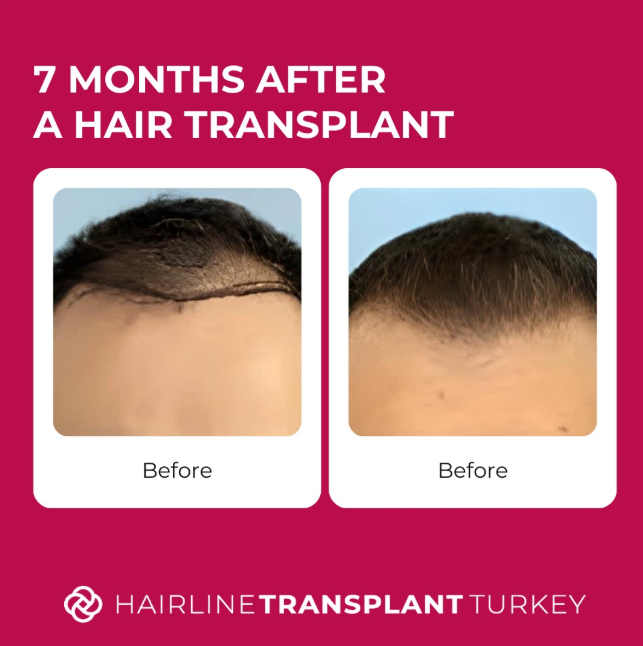
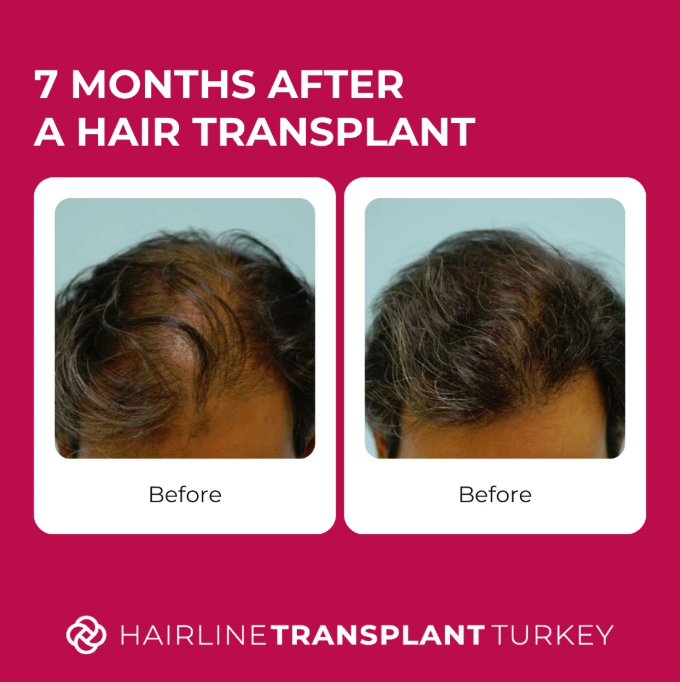
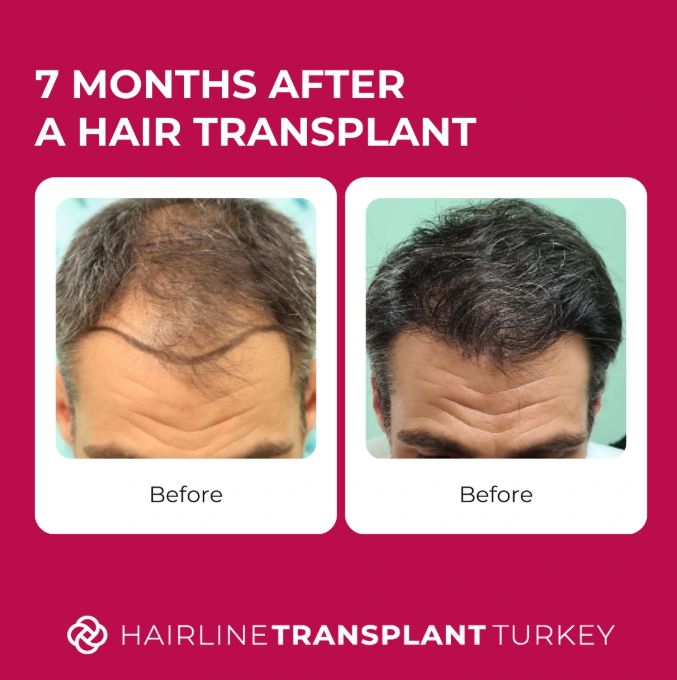
7 Months After Hair Transplant No Density: Should You Be Concerned?
If you’re at 7 months after hair transplant and are noticing no density or very sparse areas, it’s natural to feel worried. After all, at this point, you likely expected more substantial growth. However, it’s essential to remember that the hair restoration process is gradual, and patience is key.
For some patients, hair transplant results after 7 months may not show full density due to several reasons:
If you’re concerned about no density at 7 months, consult with your surgeon to assess your progress. It’s important not to panic or assume the worst at this stage, as it’s still possible that your results are simply slower to manifest.
Hair Transplant After 7 Months: Normal Expectations
By hair transplant after 7 months, your scalp should be fully healed, and any signs of redness, swelling, or scabbing from the procedure should have disappeared long ago. You can resume your normal hair care routine, including washing, styling, and using products as you normally would.
The hairs that have grown in are natural and behave just like your other hair, which means you can start experimenting with different hairstyles.
Here are some of the typical expectations for hair transplant after 7 months:
If you’re not seeing these results yet, it doesn’t necessarily mean your transplant has failed. Hair restoration is an ongoing process, and full results may not appear until 12 to 18 months after hair transplant.
Hair Fall After 7 Months of Transplant: Is It Normal?
Experiencing hair fall after 7 months of transplant can be alarming, but it’s not uncommon. Even though most of the shedding typically occurs in the first few months post-transplant, it’s possible for hair to continue falling out at this stage.
Here are some reasons why you might experience hair fall after 7 months of transplant:
7 Months After Hair Transplant Aftercare Checklist
By 7 months after hair transplant, you’re well on your way to seeing substantial progress, but your hair still needs ongoing care to achieve the best possible results. Proper aftercare during this phase can support the continued growth and overall health of your transplanted hair. Here’s a comprehensive 7 months after hair transplant aftercare checklist to help you stay on track:
1. Continue Gentle Hair Care Routine
Use a mild, sulfate-free shampoo to cleanse your scalp. Avoid harsh products that can irritate or damage sensitive areas. Wash your hair regularly to keep your scalp clean and prevent clogged follicles, but be gentle to avoid pulling or breaking new hair.
2. Avoid Excessive Heat Styling
Limit the use of heat styling tools such as hairdryers, straighteners, and curling irons. High temperatures can weaken the new hair, making it prone to breakage. If you must use heat, apply a heat protectant spray and keep the temperature on the lower side.
3. Stay Hydrated
Proper hydration is essential for healthy hair growth. Ensure you drink plenty of water daily to support your body’s ability to nourish your hair follicles.
4. Maintain a Healthy Diet
A nutrient-rich diet can enhance hair growth. Focus on foods high in vitamins and minerals, such as:
- Biotin: Found in eggs, nuts, and seeds, this vitamin supports hair strength and growth.
- Iron: Found in lean meats and leafy greens, iron helps carry oxygen to your hair follicles.
- Omega-3 Fatty Acids: Found in fish and flaxseeds, these healthy fats support hair health and prevent dryness.
5. Use a Silk Pillowcase
A silk pillowcase can reduce friction on your hair while you sleep, helping to minimize breakage and protect new growth.
6. Regular Scalp Massages
Gently massage your scalp to increase blood flow to the hair follicles. This can stimulate growth and improve the overall health of your scalp. Use a natural oil like jojoba or argan oil if your scalp feels dry.
7. Be Patient with Styling Products
While it might be tempting to start using styling gels, waxes, or pomades, keep their use to a minimum. Heavy styling products can weigh down your new hair and may clog follicles, leading to slower growth.
8. Continue Any Prescribed Medications
If your surgeon prescribed medications like minoxidil or finasteride, continue using them as directed. These treatments can help to maintain and enhance your results.
9. Avoid Direct Sun Exposure
Protect your scalp from UV rays by wearing a hat or applying sunscreen to any exposed areas. Excessive sun exposure can damage your new hair and delay healing.
10. Exercise Caution When Coloring or Treating Hair
If you’re considering coloring or chemically treating your hair, consult with your hair transplant specialist first. Harsh chemicals may damage sensitive areas or interfere with the growth of transplanted follicles.
11. Follow Up with Your Surgeon
Schedule a check-up with your surgeon if you haven’t already done so at the 6-month mark. They can assess your progress, address any concerns, and provide recommendations for continued care.
12. Avoid Smoking and Alcohol
Both smoking and alcohol consumption can impede hair growth by reducing blood circulation to the scalp and affecting the absorption of essential nutrients. Consider minimizing or eliminating them from your lifestyle.
13. Manage Stress Levels
Stress can have a direct impact on your hair health. Practice stress management techniques such as meditation, yoga, or regular exercise to promote overall well-being.
14. Monitor Hair Loss and Growth
Keep track of your progress by taking monthly photos to compare your hair growth. If you notice excessive shedding or hair fall after 7 months of transplant, consult with your doctor to ensure everything is on track.
Following this 7 months after hair transplant aftercare checklist can help you maximize your results and support the ongoing development of your new hair. Taking proper care of your scalp and hair at this stage will ensure that you get the best possible outcome from your hair transplant, allowing you to enjoy fuller, healthier hair in the months ahead.
What to Expect 7 Months After Hair Transplant
Wondering what to expect 7 months after hair transplant? Here’s a quick overview of what you should experience:
Understanding Hair Loss
Before you can truly commit to a hair transplant it is important to understand hair loss. Together with the experts at IdealofMeD, we wrote an e-book explaining everything you need to know about hair loss. From hair loss causes to practical tips on how to deal with hair loss and the best hair loss products.
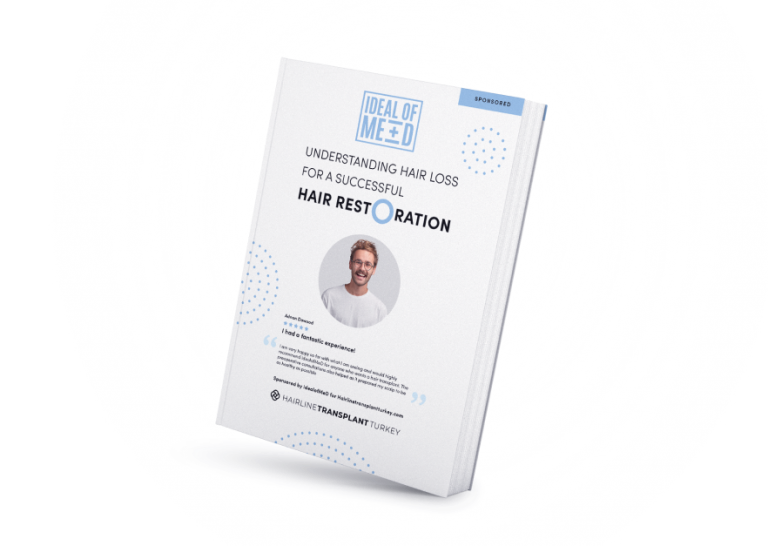
7 Months After Hair Transplant—The Journey Continues
At 7 months after hair transplant, it’s easy to become impatient if you’re not seeing the density or growth you anticipated. However, it’s essential to remember that hair restoration is a gradual process, and final results often take 12-18 months to fully manifest.
If you’re worried about 7 months after hair transplant no density, or if you’re seeing hair fall after 7 months of transplant, don’t hesitate to reach out to your surgeon for reassurance and guidance. Most of the time, these concerns are part of the normal recovery and growth process.
Ultimately, the key to a successful hair transplant after 7 months is patience. Trust in the process, take care of your hair, and look forward to continued progress in the months ahead.
Each step of the journey brings you closer to the full, natural-looking hair you’ve been working towards. By understanding what to expect 7 months after hair transplant, you can manage your expectations and stay positive as you continue to see improvements.


Tom, Lead Clinic
Researcher and Writer
Your Questions
Answered
Yes, it is completely normal to still have thin hair 7 months after hair transplant. While many people begin to notice improvements, hair density continues to increase over time. By this stage, the hair is still maturing, and you can expect more substantial growth over the coming months.
If you have no density 7 months after hair transplant, don’t worry—hair transplants require time for full results. While you should see some new hair growth, it may take 12–18 months to achieve the final density. It’s crucial to be patient as your hair follicles continue to develop.
Shedding may still occur at 7 months after hair transplant as part of the natural hair growth cycle. However, if you’re concerned about hair shedding after 7 months of transplant, consult your surgeon for reassurance. Remember, occasional shedding is common and typically part of the regrowth process.
By 7 months after hair transplant, you should see visible signs of new hair growth, though your hair may still be relatively thin. Your scalp should be fully healed, and you’ll continue to see gradual improvements in density over the next several months. Be patient, as full results often take up to a year or more.
An itchy scalp 7 months after hair transplant can occur as new hair follicles continue to grow. Mild irritation or itching is common, but if the itching is severe or accompanied by other symptoms, contact your surgeon for advice.
If you’re not seeing much growth 7 months after hair transplant, it’s important to remain patient. Hair can take several months to fully mature. In the meantime, stay consistent with your aftercare routine and speak with your hair transplant specialist if you have any concerns.
If you see no results after 4 months, don’t panic. This is still early in the recovery process, and it’s common for hair growth to be slow or minimal at this stage. Significant improvements often appear between 6 to 12 months.
Yes, at 7 months after hair transplant, it’s generally safe to begin styling your hair. However, be gentle to avoid putting stress on the new follicles. Speak to your surgeon if you’re unsure about using certain products or styling techniques.

Tom, Lead Clinic
Researcher and Writer
A Tip from Tom
Hi, I’m Tom, and since 2014, I’ve been dedicated to helping people find solutions for hair loss through writing. If you have any questions or need advice about your hair transplant journey, don’t hesitate to reach out.
Now that you’re seven months post-hair transplant, you’ve reached an exciting turning point. By now, you should start to notice more substantial growth—around 50-60% of your transplanted hair. Although your hair may still be thinner than you’d like, this is a critical stage in the hair growth cycle, and more fullness is just around the corner.
You might also notice improvements in texture and strength as your hair continues to mature. Occasional shedding may still happen, but it’s all part of the normal process. By now, your scalp is fully healed, and your hair restoration journey is progressing steadily.
It’s important to celebrate your progress! Whether it’s feeling more confident in your appearance or seeing the tangible results of your patience, each step forward is a victory.
As you move forward, you’ll soon have more options to style and experiment with your hair as it gains density. If you haven’t already, consider joining communities or forums with others who are also seven months after their hair transplant. Sharing your experiences and hearing from others can be a great source of encouragement and advice.
Stay focused and positive—your transformation is well underway, and the best is yet to come!

